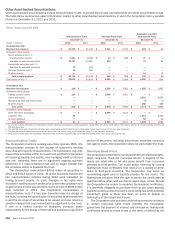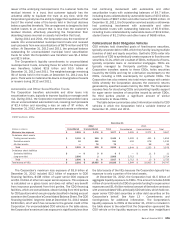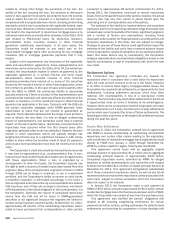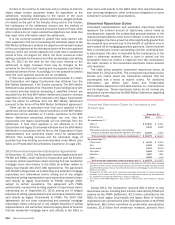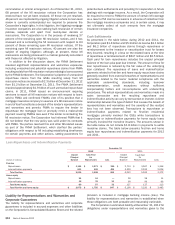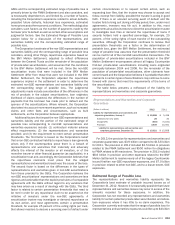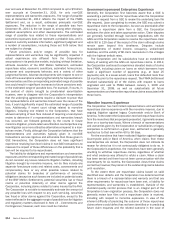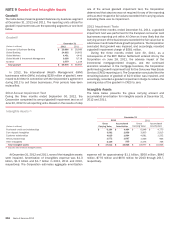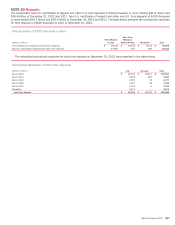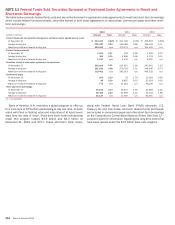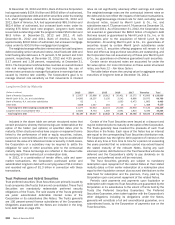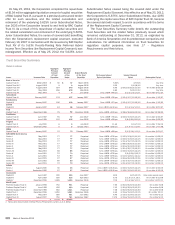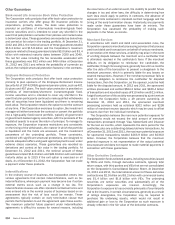Bank of America 2012 Annual Report Download - page 216
Download and view the complete annual report
Please find page 216 of the 2012 Bank of America annual report below. You can navigate through the pages in the report by either clicking on the pages listed below, or by using the keyword search tool below to find specific information within the annual report.214 Bank of America 2012
over accruals at December 31, 2012 compared to up to $5 billion
over accruals at December 31, 2011 for only non-GSE
representations and warranties exposures. The range of possible
loss at December 31, 2012 reflects the impact of the FNMA
Settlement and, as a result, addresses principally non-GSE
exposures. The reduction in the range of possible loss from
December 31, 2011 is the net impact of, among other changes,
updated assumptions and other developments. The estimated
range of possible loss related to these representations and
warranties exposures does not represent a probable loss, and is
based on currently available information, significant judgment and
a number of assumptions, including those set forth below, that
are subject to change.
Future provisions and/or ranges of possible loss for
representations and warranties may be significantly impacted if
actual experiences are different from the Corporation’s
assumptions in its predictive models, including, without limitation,
ultimate resolution of the BNY Mellon Settlement, estimated
repurchase rates, economic conditions, estimated home prices,
consumer and counterparty behavior, and a variety of other
judgmental factors. Adverse developments with respect to one or
more of the assumptions underlying the liability for representations
and warranties and the corresponding estimated range of possible
loss could result in significant increases to future provisions and/
or the estimated range of possible loss. For example, if courts, in
the context of claims brought by private-label securitization
trustees, were to disagree with the Corporation’s interpretation
that the underlying agreements require a claimant to prove that
the representations and warranties breach was the cause of the
loss, it could significantly impact the estimated range of possible
loss. Additionally, if recent court rulings related to monoline
litigation, including one related to the Corporation, that have
allowed sampling of loan files instead of requiring a loan-by-loan
review to determine if a representations and warranties breach
has occurred, are followed generally by the courts in future
monoline litigation, private-label securitization counterparties may
view litigation as a more attractive alternative compared to a loan-
by-loan review. Finally, although the Corporation believes that the
representations and warranties typically given in non-GSE
transactions are less rigorous and actionable than those given in
GSE transactions, the Corporation does not have significant
experience resolving loan-level claims in non-GSE transactions to
measure the impact of these differences on the probability that a
loan will be required to be repurchased.
The liability for obligations and representations and warranties
exposures and the corresponding estimated range of possible loss
do not consider any losses related to litigation matters, including
litigation brought by monoline insurers, nor do they include any
separate foreclosure costs and related costs, assessments and
compensatory fees or any other possible losses related to
potential claims for breaches of performance of servicing
obligations (except as such losses are included as potential costs
of the BNY Mellon Settlement), potential securities law or fraud
claims or potential indemnity or other claims against the
Corporation, including claims related to loans insured by the FHA.
The Corporation is not able to reasonably estimate the amount of
any possible loss with respect to any such servicing, securities
law, fraud or other claims against the Corporation, except to the
extent reflected in the aggregate range of possible loss for litigation
and regulatory matters disclosed in Note 13 – Commitments and
Contingencies; however, such loss could be material.
Government-sponsored Enterprises Experience
Generally, the Corporation first becomes aware that a GSE is
evaluating a particular loan for repurchase when the Corporation
receives a request from a GSE to review the underlying loan file
(file request). Upon completing its review, the GSE may submit a
repurchase claim to the Corporation. As soon as practicable after
receiving a repurchase claim from a GSE, the Corporation
evaluates the claim and takes appropriate action. Claim disputes
are generally handled through loan-level negotiations with the
GSEs and the Corporation seeks to resolve the repurchase claim
within 90 to 120 days of the receipt of the claim although claims
remain open beyond this timeframe. Disputes include
reasonableness of stated income, occupancy, undisclosed
liabilities, and the validity of MI claim rescissions in the vintages
with the highest default rates.
The Corporation and its subsidiaries have an established
history of working with the GSEs on repurchase claims. In 2012,
the Corporation continued to experience elevated levels of claims
from FNMA, including claims on loans on which borrowers have
made a significant number of payments (e.g., at least 25
payments) and, to a lesser extent, loans that defaulted more than
18 months prior to the repurchase request. The FNMA Settlement
resolved substantially all of the claims with respect to loans
originated and sold to FNMA between January 1, 2000 and
December 31, 2008, as well as substantially all future
representations and warranties repurchase claims associated with
these loans.
Monoline Insurers Experience
The Corporation has had limited representations and warranties
repurchase claims experience with the monoline insurers, due to
ongoing litigation against legacy Countrywide and/or Bank of
America. To the extent the Corporation received repurchase claims
from the monolines that are properly presented, it generally reviews
them on a loan-by-loan basis. Where a breach of representations
and warranties given by the Corporation or subsidiaries or legacy
companies is confirmed on a given loan, settlement is generally
reached as to that loan within 60 to 90 days.
For the monolines that have instituted litigation against legacy
Countrywide and/or Bank of America, when claims from these
counterparties are denied, the Corporation does not indicate its
reason for denial as it is not contractually obligated to do so. In
the Corporation’s experience, the monolines have been generally
unwilling to withdraw repurchase claims, regardless of whether
and what evidence was offered to refute a claim. When a claim
has been denied and there has not been communication with the
counterparty for six months, the Corporation views these claims
as inactive; however, they remain in the outstanding claims balance
until resolution.
To the extent there are repurchase claims based on valid
identified loan defects and the Corporation has determined that
there is a breach of a representation and warranty and that any
other requirements for repurchase have been met, a liability for
representations and warranties is established. Outside of the
standard quality control process that is an integral part of the
Corporation’s loan origination process, the Corporation does not
generally review loan files until a repurchase claim is received,
including with respect to monoline exposures. In view of the
inherent difficulty of predicting the outcome of those repurchase
claims where a valid defect has not been identified or in predicting
future claim requests and the related outcome in the case of


